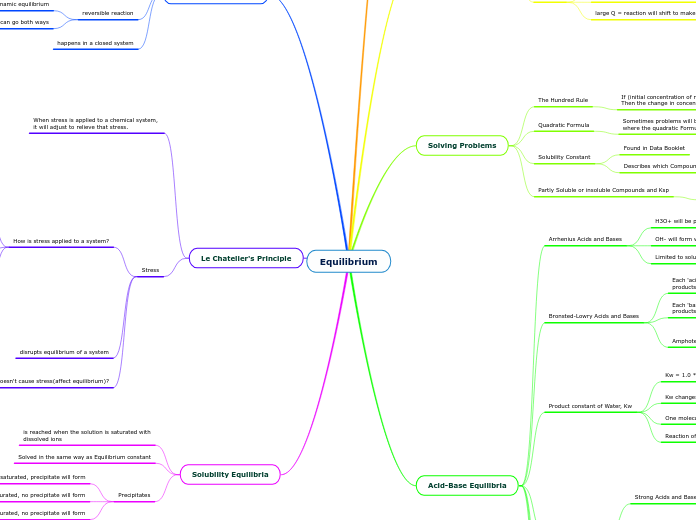Equilibrium
Equilibrium Constant(Keq)
Keq value
K = 1 , neither products or reactants favoured
small Keq = reactants favoured
large Keq = Products favored
ICE table
used to solve equilibrium problems
Heterogeneous reactions
Reactants and products are not all the same phase
Homogeneous reactions
all reactants and products are the in the same phase
Has different subscripts depending on situation, may need to be solved differently.
Keq = (products concentration)/(reactants concentration)
dimensionless
determines amounts of products and reactants at equilibrium
Reaction Quotient
calculated in the same way as the Equilibrium Constant
measures amounts of reactants and products at a given point
during the reaction
can be used to figure out if a system is at equilibria
Q values
Q = 1 , system is at equilibrium
small Q = reaction will shift to make products
large Q = reaction will shift to make reactants
Solving Problems
The Hundred Rule
If (initial concentration of reactant)/(Keq) > 100
Then the change in concentration can be discarded
Quadratic Formula
Sometimes problems will be set up in a way
where the quadratic Formula must be used.
Solubility Constant
Found in Data Booklet
Describes which Compounds are soluble or not
Partly Soluble or insoluble Compounds and Ksp
We write their Ksp using the product of the concentrations of their ions.
Acid-Base Equilibria
Arrhenius Acids and Bases
H3O+ will be produced when and acid reacts in water
OH- will form when a base reacts with water
Limited to solutions where water is the solvent
Bronsted-Lowry Acids and Bases
Each 'acid' on the reactants side has a conjugate base on the products side
An 'acid' gives away its Hydrogen atom in the reaction, conjugate base is formed on the products side
Each 'base' on the reactants side has a conjugate acid on the products side
A 'base' takes a Hydrogen atom in the reaction, conjugate acid is formed on the products side.
Amphoteric
acts as both an acid and a base
Water is amphoteric
Product constant of Water, Kw
Kw = 1.0 *10^-14 @ 25 Celcius
Kw changes with temperature
Kw can be calculated by finding the product of the concentration of Hydronium ions by Hydroxide ions
One molecule acts as an acid, the other as a base
Reaction of water and water
Acid Base Strength
Strong Acids and Bases
Ionize almost 100% in Water
No Equilibrium
Mostly ion sin solution
Strong acids will have waek conjugate bases
Strong bases will have weak conjugate acids
Weak Acids and Bases
Do not ionize completely
A weak acid will react to create a strong conjugate base
A weak base will react to create a strong conjugate acid
Acid Ionization Constant
Stronger acids have large Ka
Weak acids have small Ka
Base Ionization Constant
Stronger Bases have a large Ka
Weak Bases have a small Ka
Ka, Kb, and Kw
Ka * Kb = Kw
This equation can be rearranged to solve for what you need
A stronger acid(large Ka) will have a weaker conj. base(small Kb)
A stronger base (large Kb) will have a weaker conj. acid(small Ka)
Dynamic Equilibrium
Types of Equilibria
Chemical Reaction Equilibria
Phase Equilibria
Solubility Equilibria
reversible reaction
occurs at equal rates in dynamic equilibrium
reactions equation can go both ways
happens in a closed system
Le Chatelier's Principle
When stress is applied to a chemical system,
it will adjust to relieve that stress.
Stress
How is stress applied to a system?
Temperature
When heat is added to system, the endothermic
reaction is favoured
When heat is removed from system, the
exothermic reaction is favoured
The equilibrium constant stays constant only if
temperature is constant
Concentration
Addition of reactant or product causes the reaction
to react in a way that consumes the added substance
Removal of a reactant or product causes the reaction
to react in a way that produces the removed substance
Pressure/Volume
applies to gaseous equilibrium systems
Increase in air pressure (decrease in volume) will cause reaction to proceed in the direction which has the fewest
moles of gas
Decrease in air pressure (increase in volume) will
cause the reaction to proceed in the direction which
has the greatest moles of gas
disrupts equilibrium of a system
what doesn't cause stress(affect equilibrium)?
Addition of Catalyst
Addition of an Inert Gas
Solubility Equilibria
is reached when the solution is saturated with
dissolved ions
Solved in the same way as Equilibrium constant
Precipitates
Q > Ksp, solution is supersaturated, precipitate will form
Q < Ksp, solution is unsaturated, no precipitate will form
Q = Ksp , solution is saturated, no precipitate will form
